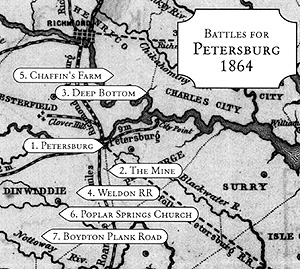
A brief summary of the Petersburg/Richmond campaign, June 15 to Oct 28, 1864:
- June 15-18, Petersburg
2nd, 5th, 9th, and 18th Corps attack
Beauregard and reinforcements from Lee in
Petersburg, frontal attack against formidable
positions.
Confederate Losses: c. 2,970 of c. 4, 100
Union Losses: c. 8,150 of 60,635
July 30, The Mine
9th Corps (+) attacks after mine blast in
Johnson's div. sector, Sanders and Mahone
restore position; frontal attack on defenses.
Confederate Losses: c. 1,500? of c.
12,000
Union Losses: 3,798 of 21,981
Aug 14-19, Deep Bottom
2nd and 10th Corps attack North of James
River.
Confederate Losses: ?? of c. 20,000
Union Losses: 2,901 of 30,080
Aug 18-2 1, Weldon RR
A.P. Hill counterattacks 5th, 9th Corps
extending around flank.
Confederate
Losses: c. 1,620 of c. 16,000
Union
Losses: , 55 o c. 30,300
Sept 29,30, Chaffin's Farm+
10th, 18th Corps attack N of James River.
Confederate Losses: c. 1,700 of c.
12,000
Union Losses: 3,327 of c. 22,000
Sept 30-Oct 2, Poplar Springs Church
5th, 9th Corps try to reach Southside RR,
counterattack by A.P. Hill.
Confederate
Losses 1, 3 10 of c. 27,000 defending
Petersburg.
Union Losses. 2,950 of c.
62,000 facing Petersburg, of which c. 24,000
attacked.
Oct 27,28, Boydton Plank Road
AT Hill, Cav. counterattack extension by
2nd, 5th, 9th Corps
Confederate Losses: ?? of c. 22,000
Union Losses: 1,758 of c. 45,000
Campaign Totals for Above
Conf Losses: c. 13,000 of c.
60,000
Union Losses: c. 27,300 of c.
90,000
(Losses from Livermore where available, except Sept 29-Oct 2 from Sommers, and some other strengths and losses from Esposito.)
So, ultimately, perhaps we can learn one important lesson from this comparison: There is no substitute for a good working relationship among the commanders of an army. In sports, one hears references to "team chemistry' that can ruin a team that has superior individual players, or can make special a team of less talented ones.
The same phenomenon is on exhibit here. With his command situation in June of 1862, Lee was not much better than Hood would be in 1864. He would show later, with trustworthy subordinates Jackson and Longstreet, that he was much, much better. Interestingly enough, one of Lee's most noteworthy failures was at Gettysburg, when he had just reorganized his armys structure command. Perhaps this command stability issue is even a dominant effect, eclipsing the issues of individual talent.
In that light, perhaps one of Hood's more important accomplishments was the death of McPherson. Hooker of Chancellorsville fame was a corps commander. With Howard, who he blamed for that defeat, now elevated to command the Army of the Tennessee, Sherman also lost the angry Hooker as a Corps commander.
Then a squabble between Palmer and Schofield frustrated Sherman's attack at Utoy Creek. Sherman, too, had command problems. Bragg's difficulties at Chickamauga, with several hastily assembled corps, also becomes more understandable. The Confederate command under similar circumstances at Shiloh was likewise a muddle. Pope's situation at Second Manassas also follows this model.
Our wargames do not do a good job of representing this. Perhaps we need to consider a system of modifications that reflect this. A negative marker might be placed on an army or other unit when command changes, or upon assembly of new major commands into the army. The marker would go away (or be reduced) with the passage of time, or perhaps after a battle. Perhaps there would also be randomly determined departures from the army due to bad relationships when a commander changes.
The Seven Days and Atlanta Campaigns Similarities and Differences
- Introduction
The Seven Days' Campaign 1862
Battles for Atlanta 1864
The Comparison
Petersburg/Richmond Campaign 1864
Wargame Representations and Simulations
Back to Table of Contents -- Against the Odds vol. 2 no. 1
Back to Against the Odds List of Issues
Back to MagWeb Magazine List
© Copyright 2003 by LPS.
This article appears in MagWeb.com (Magazine Web) on the Internet World Wide Web.
Other articles from military history and related magazines are available at http://www.magweb.com
* Buy this back issue or subscribe to Against the Odds direct from LPS.
